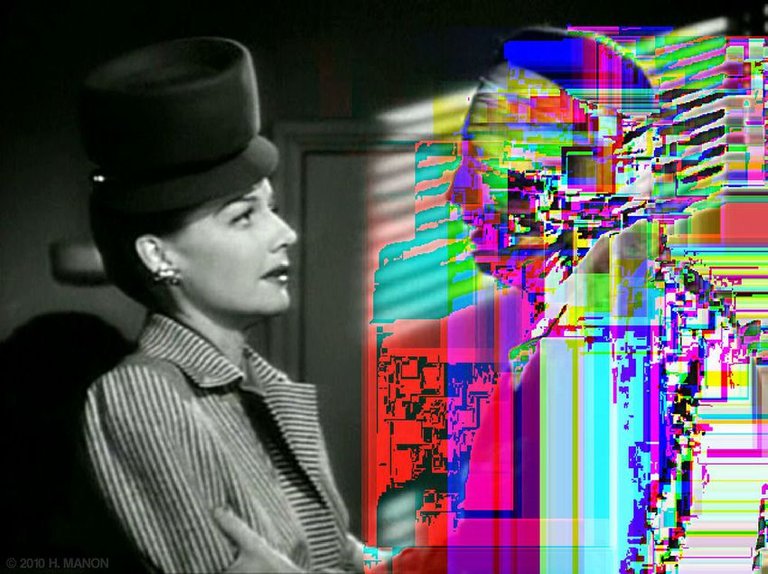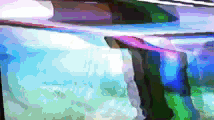
Throughout history from the Paleolithic age forward, humans have used different media to create artworks of beauty and significance from crude pigments and the carbon remains of the fire to pigments infused in linseed oil on canvas. These works had a broad spectrum of different purposes from the purely aesthetic to the spiritually significant. It would appear art is wired into the DNA of all humans.
Rewiring circuitry in devices to create art from intentional malfunctions, manipulating data files by opening one file type in a program for another file type to develop artwork, intentionally distorting media through loss of data during a file compression, and weaving multiple competing visual layers together to form one layer…
Welcome to the subculture of the Glitch Artist…
A Brief History of Glitch Art

”Curation dies out when everyone curates themselves.”
The birth of glitch art does not lie in the digital age, but rather; it first took root in the early twentieth century Dada art movement. Dadaism was an informal international movement around the outbreak of World War I, as a protest to nationalist interests, colonialist interests and cultural and intellectual conformity. It was playful, absurdist often intentionally nonsensical and Dada intended to offend.
In the 1990’s, the collective Jodi gave birth to “net art” which drew heavily from the art technique of decollage, which means to come unglued. This method involves slicing and shredding the source material until the only thing remaining is an amorphous line movement. For the next fifteen years, this genre would manifest within artworks depicting brands and logos flayed until the point of being unrecognizable, implying they are nothing more than a clever illusion. In 1999, the collective was nominated for a “net art” Webby Award, the political nature of glitch art crystallized around the acceptance speech by the collective Jodi which directly attacked the event itself as, “Ugly commercial sons of bitches.”
"In the 1990s, online art—not unlike the Internet itself—was frequently seen as a fad. ‘Net art,' struck most as garbled, tiny, and meaningless imitations of the overwhelming masterpieces on display in museums and galleries. It lacked a raison d'être."
The Glitch Art community began to organize in Chicago in the 1990's when the city hosted major digital media conferences The International Symposium of Electronic Art and SIGGRAPH. In the next decade, glitch artists began to self-identify with the descriptor "glitch artist" and in 2010 Nick Briz, a Chicago-based glitch artist organized the first GLI.TC/H festival. The festival grew, panned out internationally to Amsterdam and Birmingham. On the heels of the social media revolution, glitch art became a bonafide art movement featured in such renowned institutions as the UK’s Tate Britain, The Getty Images Gallery, The Ukrainian Institute of Modern Art in Chicago and The Dogpatch Café & Art Gallery in San Francisco.
What Exactly is a Glitch Art?

”The essence of glitch art is pretty simple: humans subject themselves to technology and exert control over it to a greater or lesser extent to produce a piece of artwork that is a product of both the creator’s intention and the device’s whims.”
The term "glitch" is derived from Yiddish words conveying the idea of slippage. NASA engineers and astronauts first popularized the term during the Project Mercury Mission in 1962.
"One of the characteristics of glitch, aside from its origins in errors and system overload, feedback and so on, is that when people try to do it concretely, they often end up working directly with the material of the file itself, below the level of its representation, as an image, or as text, or as audio…."
Glitch art is the process of exploiting misbehavior, and this process can take place either within the electronic media itself or the encoding behind the electronic media. The process of glitch art production has much more weight and importance than the composition of the finished glitch art product. A host of different techniques can be used to create the glitch:
- Circuit Bending is the purposeful rewiring or alteration to the circuitry of a device with the intention of setting up a glitch.
- Data Bending is the purposeful manipulation of a data file with the intention of setting up a glitch. At its most simple, it could be opening one type of file (such as a video file) in an application designed to interpret a different kind of file (such as a text application).
- Pixel Drifting is utilizing or creating applications with the purpose of chopping up and reproducing a file’s foundation.
- Datamoshing is the process of intentionally distorting media during a file compression cycle.
- Z-Fighting is a process of weaving multiple visual layers together to form one layer.
Glitch art, once looking for a reason to be outside internet memes and Webby Awards, has managed to gain legitimacy and recognition in more “established” institutions of classic art:
- Tate, UK, (http://www.tate.org.uk/whats-on/tate-britain/special-event/open-call-submission-all-glitched)
- Getty Images Gallery, (http://www.gettyimagesgallery.com/exhibitions/archive/glitch.aspx)
- Ukrainian Institute of Modern Art, (http://uima-chicago.org/glitchicago-an-exhibition-of-chicago-glitch-art/)
- The Dogpatch Café & Art Gallery, (http://www.artslant.com/sf/events/show/362945-glitch-an-exhibition-of-digital-decay)
It would appear what started as ‘net art’ has morphed into something more enduring.
Capitalism and the Glitch Art Subculture

In recent times, investment banking has jumped into the sphere of art, commoditizing art in a way which is almost unprecedented. Hedge funds and investment banks have developed art funds, which has the knock-off effect of positioning artworks like securities, rather than expressions of creative genius. This new trend has given rise to a host of private museums and caused the work of young, relatively unknown artists, to triple and quadruple in value almost overnight.
As one could imagine this has both good and bad unintended consequences over time, but the art market looks to be experiencing a bubble similar, but much larger, than the last art bubble experienced at the peak of the dotcom bubble.
The market for glitch art is profound and much like its more established art genres, from an economic standpoint, has been benefiting from the commoditization bubble as evidenced by the links below:
- Museum of Glitch Aesthetics, (http://www.glitchmuseum.com/)
- Glitchet, (http://www.glitchet.com/resources)
- Artprice, (http://www.artprice.com/artmarketinsight/turquish-contemporary-artists)
“As we become more and more wrapped up in technology, glitch art has begun to be taken more seriously as a movement with a unique potential for timely cultural commentary, rather than just an aesthetic embraced by individual artists.”
References
Roy, Mallika. “Glitch It Good: Understanding the Glitch Art Movement.” The Periphery. December 2014. http://www.theperipherymag.com/on-the-arts-glitch-it-good/
Klee, Miles. “The Long, Twisted History of Glitch Art.” The Kernel. March 22, 2015. http://kernelmag.dailydot.com/issue-sections/features-issue-sections/12265/glitch-art-history/
Wikipedia. “Dada.” N.p. September 19, 2016. https://en.wikipedia.org/wiki/Dada
Amirtha, Tina. “Inside the Bizzare Phenomenon Known as ‘Glitch Art’.” Fast Company. August 12, 2014. https://www.fastcompany.com/3034296/inside-the-bizarre-phenomenon-known-as-glitch-art
Wong, Grace. “It’s Not a Bug, It’s a Feature: The Rise of Glitch Art.” The Guardian. October 25, 2013. https://www.theguardian.com/artanddesign/2013/oct/25/rise-of-glitch-art
Interesting movement, didn't know about the sub-categories.... thanks and following!
@matericlook thanks for the comment and the follow. I appreciate it.
When I wrote this piece, I was fascinated at the evolution of art in the digital age. Using intentional errors in created with computers as new media for artwork (I thought) was brilliant.
I have a piece on Vaporwave I have half-finished, which I should complete and post . It's another very cool subculture in the world of art and music which I think has some unique points about it which deserve a moment in the spotlight.
If you enjoyed this piece of th Sbcultures and Social Trends series, I have another 16 or so pieces in this serie you may want to check out. LAtely i have been focusing some time and attention on the sister series to this called Deeper Dives. In that series, I go and experience these subcultures firsthand, so the production time for that series is considerably longer.
Thanks again for the follow.
Thanks a lot, smart and interesting pieces, still reading!
Excellent post. I do something I call glitch art but perhaps it is something else. I would like to get your opinion. I really don't know what to call it do you?
I have a technique where I run a single VHS tape through two VCR decks and then combine the signal from both machines into one TV.
 - Crash Twice
- Crash Twice
 - Cigar
- Cigar
These are gifs that I made from the effect.
This is a longer video called Deja View
https://steemit.com/dtube/@bardionson/afszhn9kI also made it into a flip for those analog situations
This link describes a live interactive glitch machine. It is a variation where one VCR deck records from a camera and the other plays back. The feedback from the TV is fed back into the video camera.
https://steemit.com/art/@bardionson/time-and-space-loop-an-interactive-installation
This is absolutely Glitch art, and I think it would fall under Datamoshing. Very cool you engage in this regularly. Have you thought of putting up a post walking people through your process? I'd love to see that.
Great datamoshing. Now I have a tag to put on it.
Yes I have thought about it. I really need to video the process. It could be either tedious or hilarious as I try to keep the tape feeding correctly through two vcr. I recently thought of an alternate method that might be easier. When I have some time I will see if I can write it up.
Here is a quick view of my recording "system"
FictionOk @ipfaust here is my method https://steemit.com/art/@bardionson/my-method-for-making-glitch-art
Very interesting topics, following :)
Thanks for taking the time to check out the article and following. I appreciate it.
Interesting take on glitch art benefiting from the commoditization bubble. There are certainly a number of artists pushing the envelope and ended up with some key signatures, but that's really out of probably like a gazillion glitch art being made on a daily basis, so disposable that you get numbed by them after scrolling through a dozen.. but I like it that anyone can just experiment with the many different glitching methods, and they're not really set in stone so it's pretty fun to do :)
I came across the subculture quite by accident, then when I read about what circuit benders were doing, I got interested. I thought the history of glitch art was pretty killer also with it's links to the Dada movement in World War I. After our chat a couple days a go, I hope you enjoyed this piece on glitch art. At some point, I plan to touch on Vapourwave and some related subcultures.
Pretty killer things happening in modern art.
I am fascinated by the Fluxus movement and Nam June Paik. It seems like his work has had some impact on glitch art.

I have run across another subculture of visual art and music using oscilloscopes and laser art. I see that this circuit bending, oscilloscope, laser work seems to be used in music and dance venues where you have visual effects to go with the music.
DOPE
This post has been linked to from another place on Steem.
Learn more about and upvote to support linkback bot v0.5. Flag this comment if you don't want the bot to continue posting linkbacks for your posts.
Built by @ontofractal
I like your blog! Followed, please watch my glitch art blog @dolores.meiwes
Always a delayed reaction when I suddnly discover someone has been checking out and commenting on my content I created a year ago. Glad to see it and thanks for giving it a read.
I checked out your glitch art and have followed your blog. Great stuff .
Thanks 4 check ma blog, Im noob jajaja...
This is an excellent post. I am excited to consume more of your content! I glitch art as well